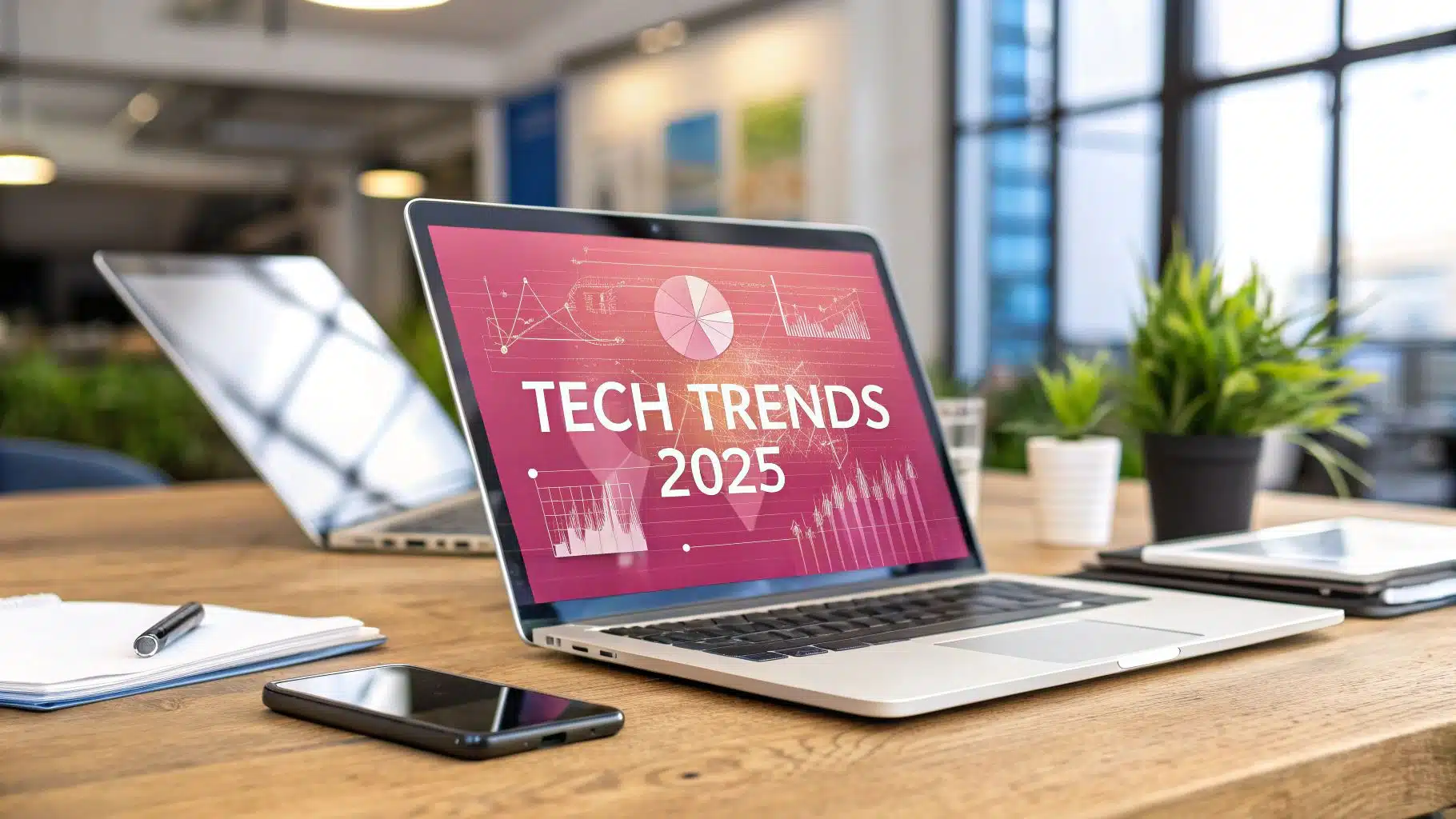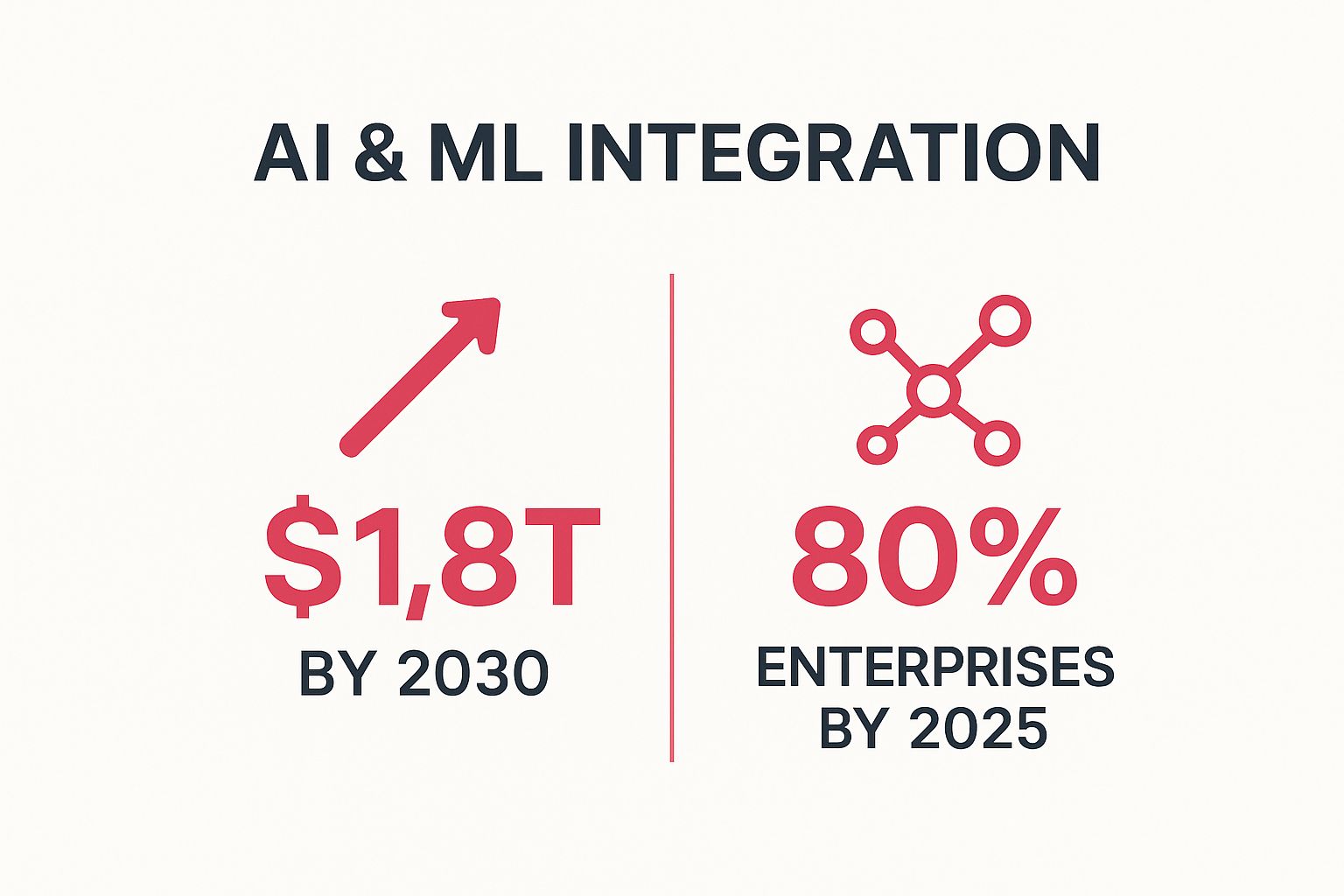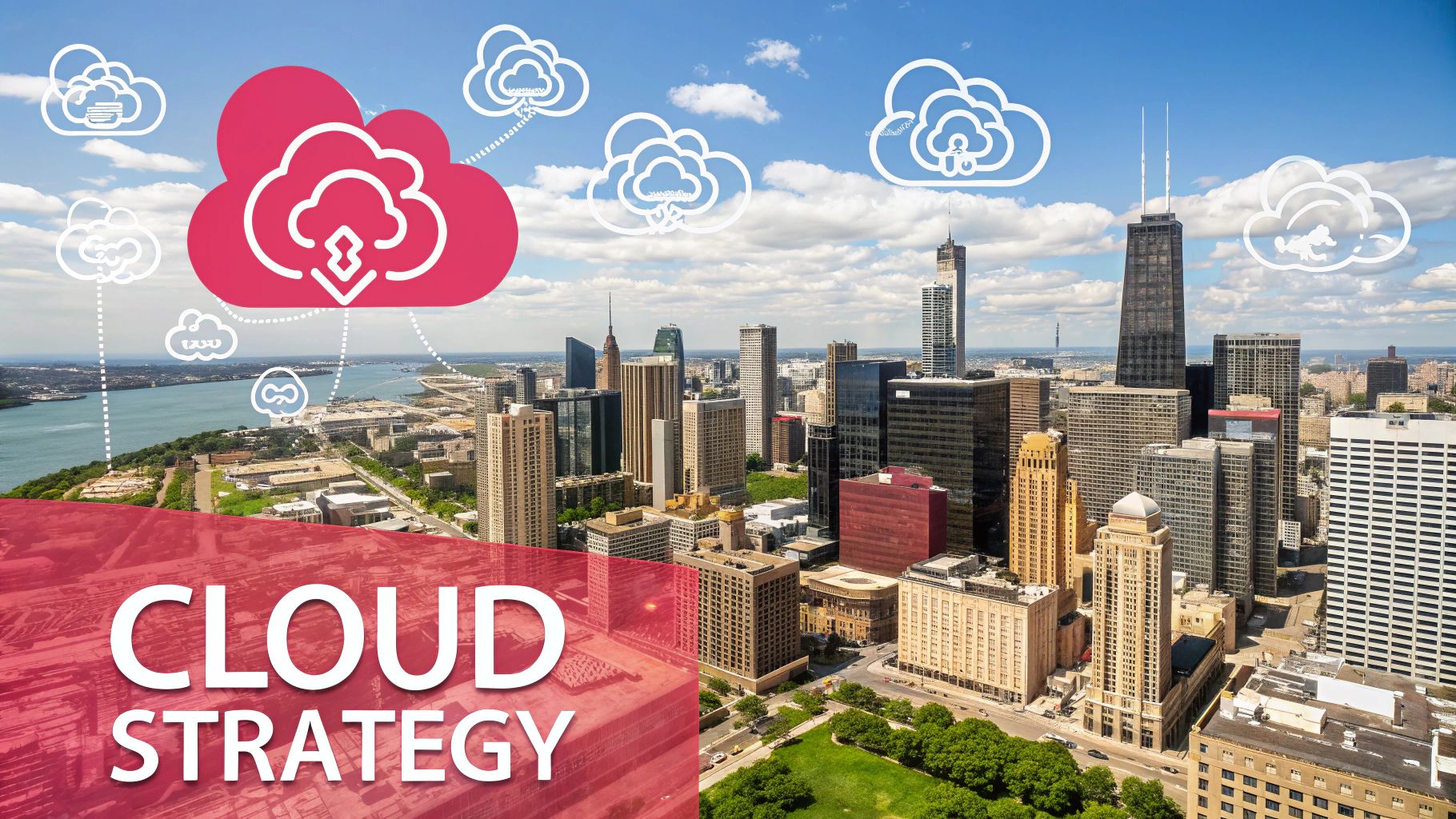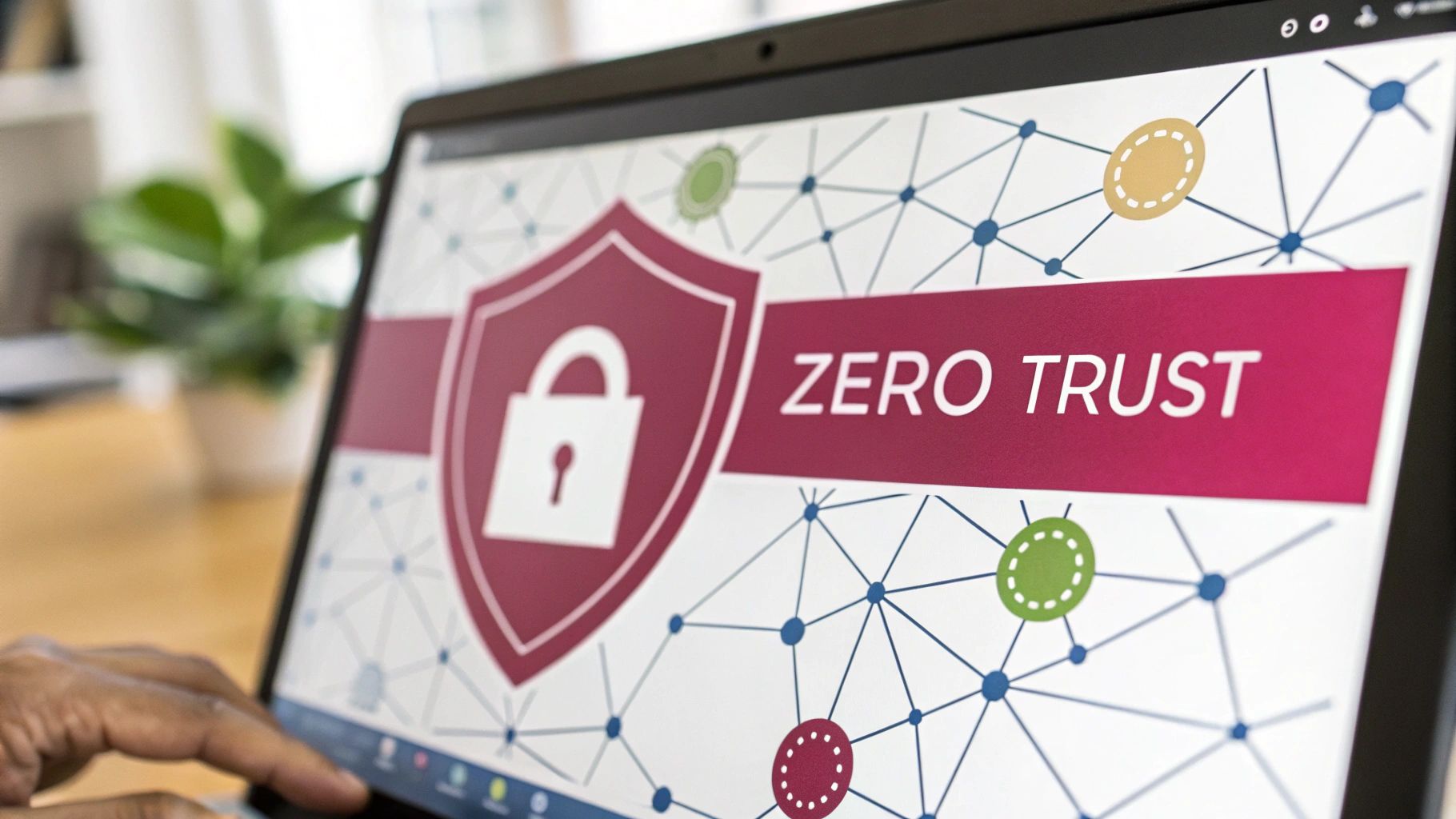Discover the top 10 business technology trends for 2025. Actionable insights for UK professional services to drive growth and efficiency. Read more.

In today's fast-paced market, staying ahead is not just an advantage; it's a necessity for survival and growth. For small and medium-sized enterprises (SMEs) across Dorset, Somerset, and other UK regions, particularly those in professional services like accountancy or care, harnessing the right technology is the key to unlocking new levels of efficiency and client value. The coming year promises a new wave of innovation, but navigating which advancements truly matter can be a significant challenge for busy decision-makers.
This article cuts through the noise to deliver a practical guide to the most impactful business technology trends set to shape the future. We move beyond buzzwords to provide a clear, actionable roadmap tailored for UK businesses. Inside, you will find detailed explanations of each trend, from integrating artificial intelligence to enhance client services to adopting robust, proactive cybersecurity frameworks that protect your sensitive data.
We will explore real-world examples and offer concrete implementation steps for each technology, helping you make informed decisions. This roundup is designed to help you optimise operations, strengthen compliance, and secure a decisive competitive edge. Let's explore the ten essential technologies poised to redefine your business strategy and prepare you for what's next.
Artificial Intelligence (AI) and Machine Learning (ML) are no longer futuristic concepts; they are foundational business technology trends actively reshaping industries. This trend involves integrating intelligent algorithms into core business operations to automate tasks, derive insights from data, and enhance decision-making. By learning from data patterns, AI systems can perform tasks that traditionally required human intellect. For a professional services firm, this could mean an AI tool that analyses thousands of legal contracts to identify key clauses, or a system for an accountancy practice that automates the categorisation of expenses with near-perfect accuracy.
This technology is pivotal for gaining a competitive edge. It allows businesses to move beyond reactive problem-solving to proactive, predictive strategies. For instance, AI can forecast cash flow for a financial advisory client, optimise resource allocation in a consultancy, and even predict client churn, enabling you to take preventative action. In client services, AI-powered chatbots provide 24/7 support for routine queries, freeing up human advisors to handle more complex strategic issues. For a deeper dive into specific applications, explore how AI is shaping call centres in the coming years with the latest AI trends in call centers for 2025.
The rapid adoption and economic impact of AI are staggering, underscoring its importance for any forward-thinking organisation.

These figures highlight a clear trajectory: AI integration is becoming standard practice, generating substantial economic value and transforming how businesses operate.
Adopting a cloud-first posture has become a defining business technology trend for modern organisations. This strategy involves prioritising cloud solutions for new IT projects and migrating existing infrastructure away from on-premise servers. A more advanced approach, the multi-cloud strategy, utilises services from two or more cloud providers like AWS, Microsoft Azure, or Google Cloud. This prevents vendor lock-in, optimises costs by selecting the best service for each workload, and enhances resilience through redundancy. For instance, a law firm might use a highly secure, specialised cloud for its case management system while using Microsoft Azure for its standard office productivity tools.

This strategic shift empowers businesses with unparalleled flexibility, scalability, and operational efficiency. Instead of purchasing and maintaining expensive physical hardware, companies can pay for computing resources as needed, scaling up during peak periods and down during quieter times. This is particularly beneficial for professional services firms, such as accountants, who experience seasonal demand during tax season. The cloud also facilitates secure remote work and collaboration, which is now a cornerstone of business continuity. Realising the full scope of these advantages is crucial for any business looking to compete, and you can explore the extensive cloud computing benefits for businesses to build a stronger case for adoption.
As businesses embrace digital transformation, the traditional security model of a defensible network perimeter has become obsolete. This is where Cybersecurity-by-Design and Zero Trust Architecture emerge as critical business technology trends. This approach operates on the principle of "never trust, always verify," assuming no user or device, whether inside or outside the network, should be trusted by default. It embeds security into the fabric of the IT infrastructure from the outset, rather than applying it as an afterthought.
This model is a paradigm shift from reactive defence to proactive security posture management. Instead of building a wall around your assets, you secure each individual resource and enforce strict access controls for every request. For a professional services firm, this means a partner working from a client site must re-authenticate to access every file, application, or database, just as they would if they were a new user. For businesses like accountants or care providers, this ensures sensitive client data is protected at every level, a crucial factor for compliance and trust.
The move towards Zero Trust is driven by the increasing sophistication of cyber threats and the dissolution of the traditional office environment.

These figures show that Zero Trust is no longer a niche concept but a mainstream strategy essential for mitigating risk and building a resilient organisation.
The democratisation of software development is one of the most transformative business technology trends, driven largely by low-code/no-code (LCNC) platforms. This trend empowers non-technical staff, often called citizen developers, to build and deploy business applications using intuitive graphical interfaces, drag-and-drop components, and pre-built templates. Instead of writing complex code, users can design workflows and create custom tools, dramatically accelerating innovation. For example, an accountancy firm can build a bespoke client onboarding portal, or a care provider can create an application for tracking patient visits, all without relying on a dedicated IT department.
This approach is pivotal for agility and efficiency, allowing businesses to respond rapidly to changing needs. It bridges the gap between business requirements and technical implementation, enabling teams to solve their own problems. Platforms like the Microsoft Power Platform and Airtable allow users to create everything from simple data collection forms to sophisticated project management dashboards. This significantly reduces the IT backlog and fosters a culture of innovation across the organisation. For businesses keen on optimising their development overheads, exploring these platforms is essential. You can learn more about strategies for long-term savings in software development on sescomputers.com.
The Internet of Things (IoT) and edge computing represent a powerful convergence of business technology trends, transforming how organisations gather and act on real-time data. IoT involves a network of interconnected devices and sensors that collect and exchange information, while edge computing processes this data locally, close to its source, rather than sending it to a centralised cloud. This combination enables instant insights and automated responses, creating smarter, more efficient business operations.
This trend is critical for organisations that rely on immediate data for decision-making. For professional services, this could manifest in smart office buildings that optimise energy use based on occupancy, reducing overheads. In the care sector, IoT sensors can monitor vulnerable clients at home, sending instant alerts to care providers in case of a fall or other emergency, with edge computing ensuring the alert is processed immediately without relying on internet latency. This approach moves businesses from reactive analysis to proactive, automated control over their physical environments.
The growth of IoT and its partnership with edge computing is creating a new frontier for data-driven operations and automation across industries.
These figures illustrate a clear shift towards decentralised intelligence, where data is processed at the source for maximum speed and relevance.
Robotic Process Automation (RPA) is a significant business technology trend that allows organisations to automate high-volume, repetitive digital tasks. Unlike physical robots, RPA utilises software "bots" that mimic human actions to interact with digital systems. These bots can log into applications, enter data, calculate, and complete rule-based tasks, all without human intervention. For a professional services firm like an accountancy practice, an RPA bot can automatically download bank statements, extract transaction data, and populate it into accounting software, saving hundreds of hours of manual work per month.
This technology is transformative for businesses looking to streamline operations and reduce costs. By automating mundane processes like invoice processing, data entry, or client record updates, RPA frees up skilled employees to focus on higher-value activities that require strategic thinking, client interaction, and complex problem-solving. This not only boosts productivity but also enhances employee satisfaction by eliminating tedious work. Platforms from leaders like UiPath and Automation Anywhere are making this powerful technology more accessible to small and medium enterprises.
The growth and impact of RPA are compelling, demonstrating its established role in modern business operations and its potential for substantial returns on investment.
These figures confirm that RPA is not a fleeting trend but a core component of digital transformation, offering tangible benefits in efficiency and cost reduction.
Augmented Reality (AR) and Virtual Reality (VR) are immersive technologies that are moving from consumer entertainment into practical business applications. This business technology trend involves overlaying digital information onto the real world (AR) or creating entirely digital environments (VR). These tools are transforming core operations like training, product visualisation, and client engagement, offering innovative ways to interact with information and physical spaces.
This trend is crucial for businesses aiming to create more impactful and efficient processes. For example, architects and engineering firms can use VR to walk clients through a virtual model of a proposed building, allowing for immediate feedback and design changes before construction begins. In the care sector, VR can be used for empathy training, allowing staff to experience the challenges faced by patients with specific conditions. In legal services, AR could overlay case evidence onto a real-world environment during trial preparation.
The practical applications of AR and VR are expanding rapidly across industries, providing tangible returns on investment and enhancing operational capabilities.
These use cases demonstrate that AR and VR are powerful tools for solving real-world business challenges, from upskilling employees to creating unforgettable client experiences.
Blockchain and Distributed Ledger Technology (DLT) are moving far beyond their origins in cryptocurrency to become a transformative business technology trend. This technology utilises a decentralised, immutable digital ledger to record transactions across many computers, ensuring that any record cannot be altered retroactively without the alteration of all subsequent blocks and the consensus of the network. This creates unprecedented levels of transparency, security, and traceability for business processes.
The application of blockchain is proving pivotal for industries where trust and provenance are paramount. For professional services, this translates into smart contracts that automatically execute terms of an agreement—such as releasing payment upon completion of a project milestone—reducing administrative overhead and disputes. A law firm could use it to create an unalterable chain of custody for digital evidence, while an accountancy practice could use it for triple-entry bookkeeping, providing a tamper-proof record shared between a business, its customers, and its suppliers. One significant application is the adoption of secure blockchain payment solutions, which can reduce transaction costs and settlement times.
The growing investment and projected market size for blockchain technology underscore its increasing importance and potential for delivering significant business value.
These figures illustrate that organisations are increasingly recognising blockchain's capacity to streamline operations, enhance security, and create new business models.
The rollout of 5G represents a monumental leap in wireless communication, far exceeding the incremental improvements of previous generations. This business technology trend provides ultra-fast data speeds, significantly reduced latency, and the capacity to connect a massive number of devices simultaneously. It moves beyond simply faster mobile browsing, acting as a catalyst for transformative applications like real-time data analytics, large-scale Internet of Things (IoT) deployments, and immersive augmented reality (AR) experiences for training and client support.
This enhanced connectivity is critical for businesses aiming to operate at the edge of innovation. For professional services firms, this means a consultant can download and analyse a massive client dataset in seconds while on-site, or a surveyor can transmit high-definition drone footage from a remote location in real time. For UK businesses, this opens doors to smarter operations, from an accountancy firm securely accessing cloud data instantly to a care provider using reliable telehealth services with crystal-clear video quality.
The rapid expansion and economic potential of 5G underscore its role as a foundational infrastructure for future business growth and innovation.
These figures illustrate that 5G is not just an upgrade but a core enabler of the next wave of digital transformation, creating new business models and revenue streams.
Sustainable Technology, often called Green IT, is a critical business technology trend focused on minimising the environmental footprint of IT operations. This involves adopting energy-efficient hardware, utilising renewable energy sources for data centres, and integrating circular economy principles to reduce e-waste. As organisations like Microsoft pursue carbon-negative goals, this trend moves from a corporate social responsibility talking point to a core operational strategy, enhancing brand reputation and long-term resilience.
This approach is pivotal for future-proofing a business against regulatory changes and shifting consumer expectations. Green IT not only reduces operational costs through lower energy consumption but also aligns your organisation with the values of environmentally conscious clients and partners. For a professional services firm, this could mean choosing a cloud provider that runs on 100% renewable energy or implementing a device lifecycle policy that prioritises repair and refurbishment over replacement. The integration of artificial intelligence is also transforming green initiatives, with leading sustainability software leveraging AI to enhance data analysis and reporting for environmental impact.
The push towards sustainability is backed by significant data, highlighting both environmental necessity and economic opportunity.
Globally, data centres consume an estimated 200 terawatt-hours (TWh) of electricity each year, an amount greater than the national energy consumption of some countries. Adopting Green IT practices can reduce this figure by optimising energy use and shifting to renewable sources. This move is not just ecological but also economical, as energy costs are a major operational expense for any business with a digital presence.
These figures underscore the urgency and benefit of integrating sustainability into your technology strategy, transforming a cost centre into a source of efficiency and value.
TechnologyImplementation ComplexityResource RequirementsExpected OutcomesIdeal Use CasesKey AdvantagesArtificial Intelligence and Machine Learning IntegrationHigh – requires technical expertise and data qualitySignificant initial investment, skilled staffAutomation, enhanced decision-making, personalisationProcess automation, predictive analyticsIncreased efficiency, reduced errors, 24/7 operationCloud-First and Multi-Cloud StrategiesModerate to high – requires planning and managementOngoing subscription costs, cloud expertiseScalability, cost optimisation, reliabilityInfrastructure modernisation, workload migrationFlexibility, reduced infrastructure costs, disaster recoveryCybersecurity-by-Design and Zero Trust ArchitectureHigh – complex integration and cultural changeSpecialised security skills, higher upfront costsEnhanced security, continuous verificationSecurity-sensitive environments, remote workReduced attack surface, regulatory compliance, real-time threat responseLow-Code/No-Code Development PlatformsLow to moderate – user-friendly but requires governanceLower development costs, some training neededFaster app development, empowered non-technical usersRapid prototyping, business user-driven appsFaster delivery, reduced IT dependency, cost-effectiveInternet of Things (IoT) and Edge ComputingHigh – device management and network complexityHigh infrastructure investment, security focusReal-time insights, predictive maintenanceIndustrial automation, supply chain trackingImproved efficiency, real-time decisions, cost reductionRobotic Process Automation (RPA)Moderate – process standardisation neededModerate setup costs, bot management skillsAutomates repetitive tasks, cost savingsRule-based repetitive processesQuick ROI, accuracy improvement, 24/7 operationsAugmented Reality (AR) and Virtual Reality (VR)High – hardware and content development costsSignificant investment in devices and trainingEnhanced engagement, immersive trainingEmployee training, product visualisationBetter visualisation, reduced costs, remote collaborationBlockchain and Distributed Ledger TechnologiesHigh – technical complexity and regulatory issuesSignificant expertise, energy/resource intensiveTransparency, fraud reductionSupply chain, secure data sharingDecentralisation, immutable records, enhanced security5G and Advanced Connectivity SolutionsHigh – infrastructure upgrades requiredHigh infrastructure costs, device compatibilityFaster connectivity, massive device supportIoT deployments, real-time analyticsLow latency, high speed, new business opportunitiesSustainable Technology and Green ITModerate to high – requires sustainability integrationHigher initial investment, monitoring toolsReduced environmental impact, cost savingsEnergy management, green supply chainsImproved reputation, long-term cost savings, compliance
Navigating the landscape of emerging business technology trends can feel like trying to hit a moving target. However, as we have explored, these advancements are not just fleeting novelties; they are foundational pillars for the future of commerce. From the predictive power of Artificial Intelligence and the scalability of multi-cloud strategies to the democratic innovation offered by low-code platforms, each trend represents a powerful opportunity. The common thread weaving through them all is the drive for greater efficiency, enhanced security, and deeper client engagement.
For small and medium-sized businesses, particularly professional services firms like accountants or care providers in Dorset, Somerset, Wiltshire, and Hampshire, the message is one of strategic adoption, not overwhelming revolution. The goal is not to implement all ten technologies at once. Instead, it is to identify the specific operational bottlenecks or strategic goals where technology can deliver the most significant impact.
The transition from understanding these trends to leveraging them requires a deliberate and measured approach. Rather than seeing this as a single, monumental project, view it as a series of strategic steps tailored to your unique circumstances.
Ultimately, mastering these business technology trends is about more than just modernising your toolkit. It is about building a more agile, resilient, and competitive organisation. It is about empowering your team to focus on high-value work, securing your operations against an evolving threat landscape, and delivering the seamless, responsive service that today’s clients expect. By taking a proactive, informed, and strategic approach, you can transform these powerful technological shifts from abstract concepts into tangible business triumphs, securing your organisation's success for years to come.
Ready to turn these technological trends into your competitive advantage? The experts at SES Computers specialise in helping businesses across Dorset, Somerset, and the South West implement robust cybersecurity, scalable cloud solutions, and bespoke IT strategies. Visit SES Computers to discover how our tailored support can help your business thrive in the digital age.